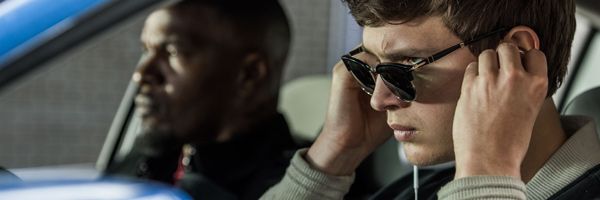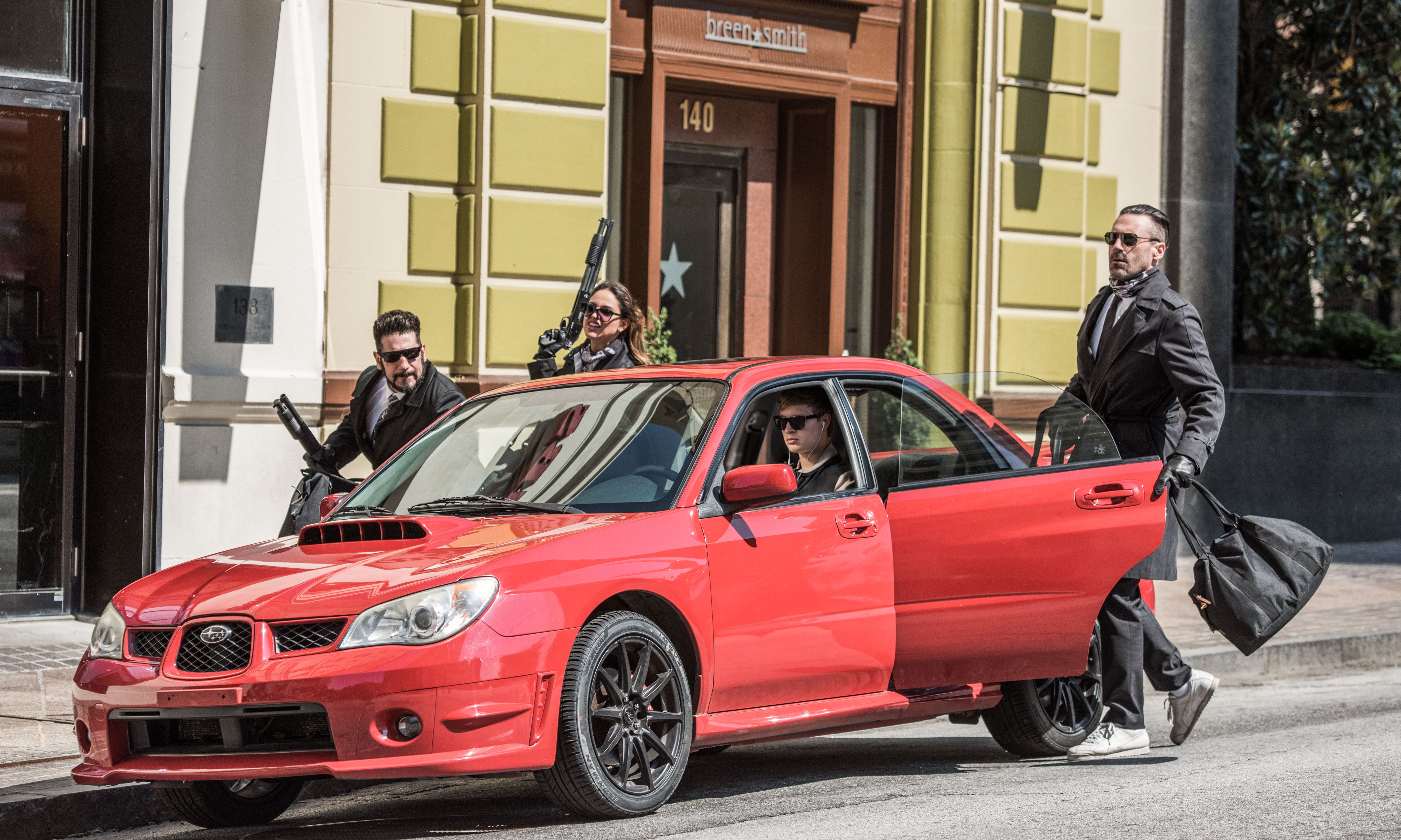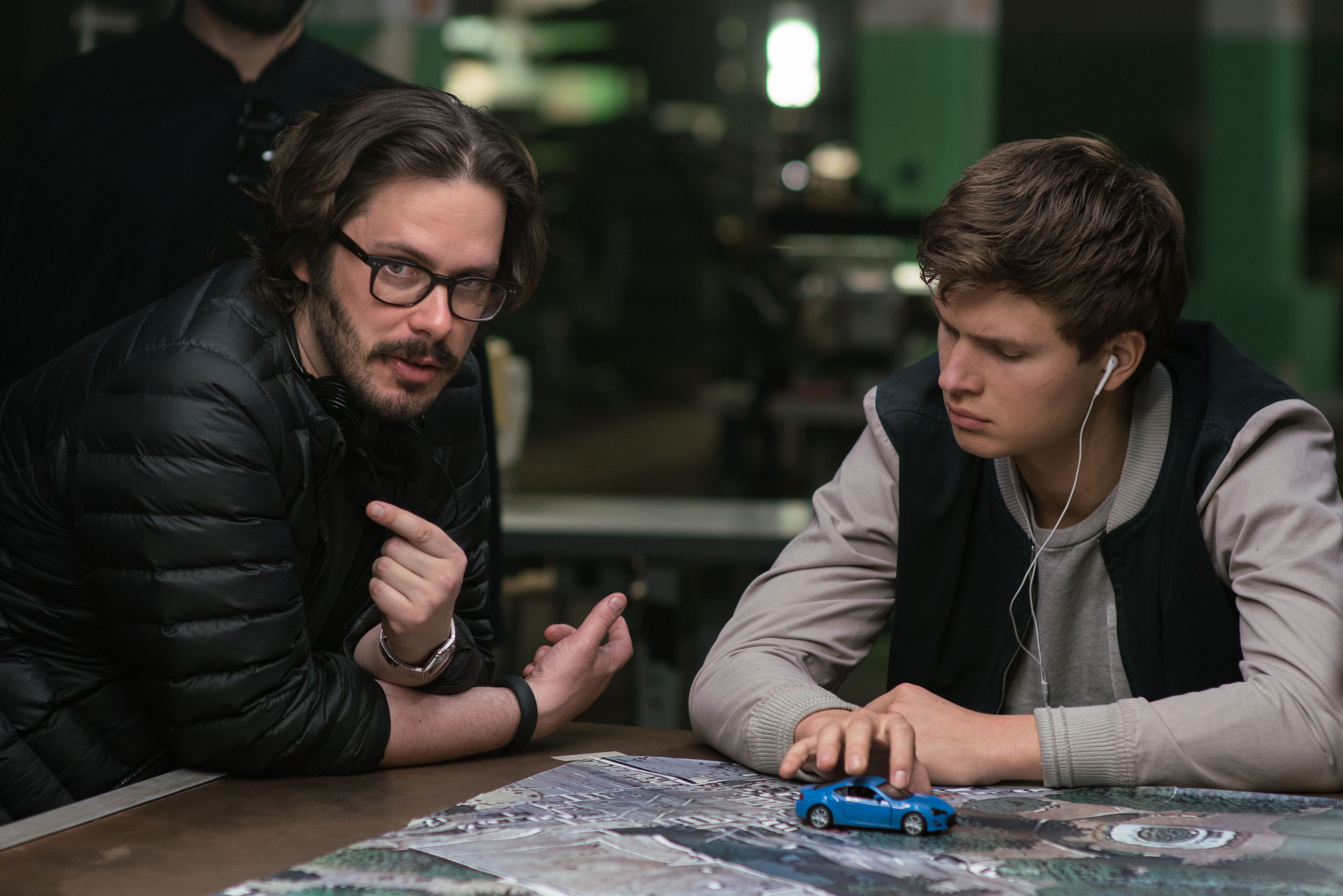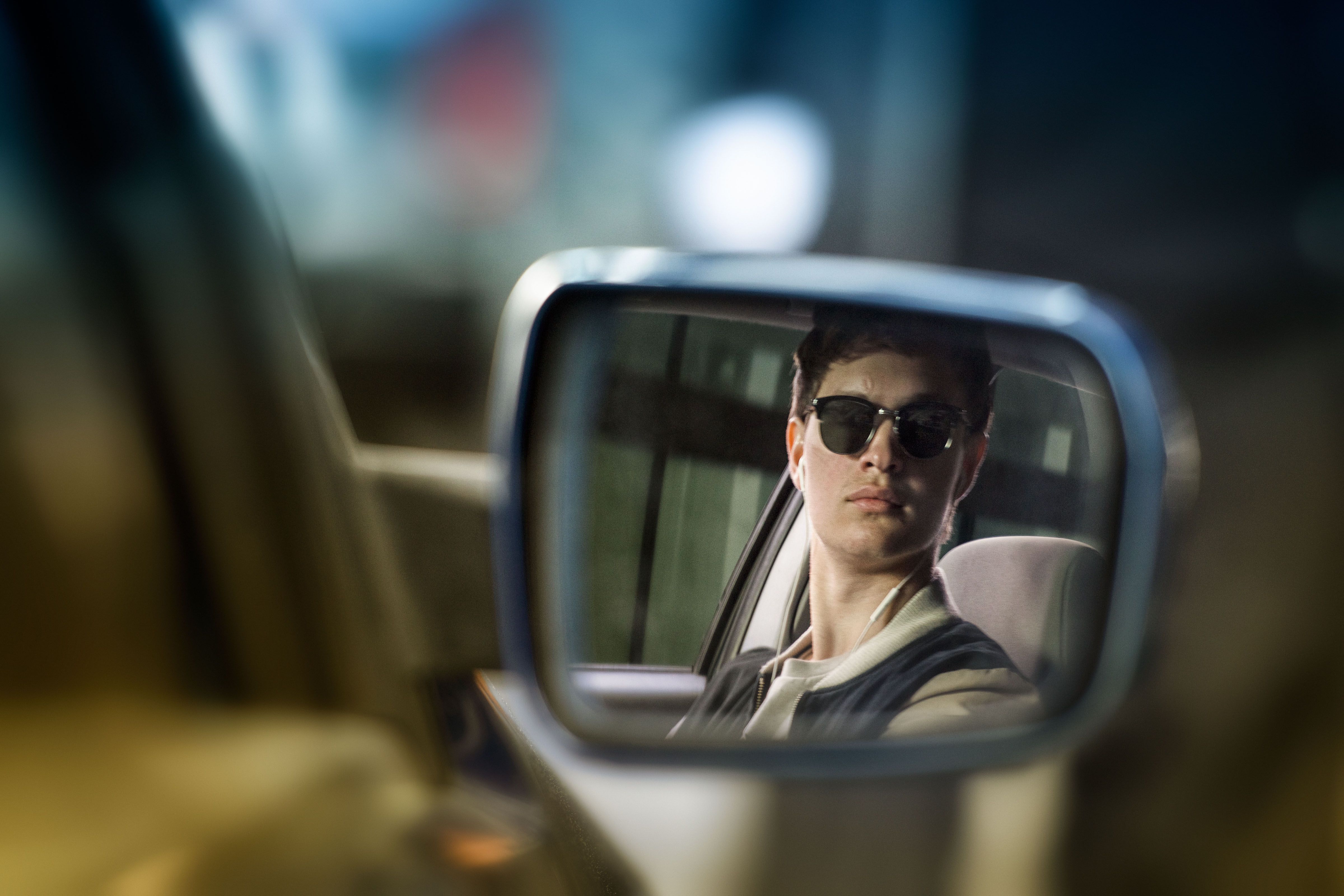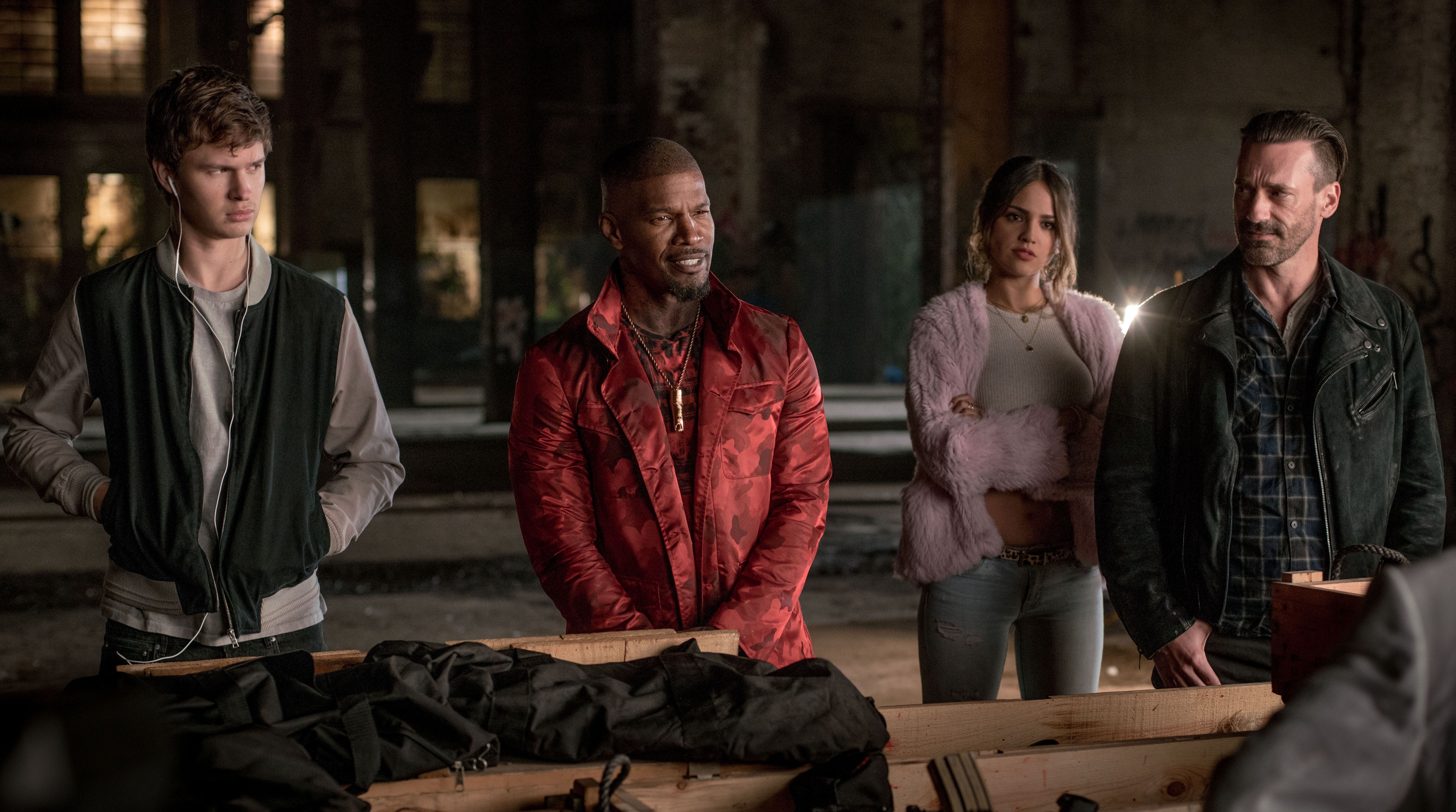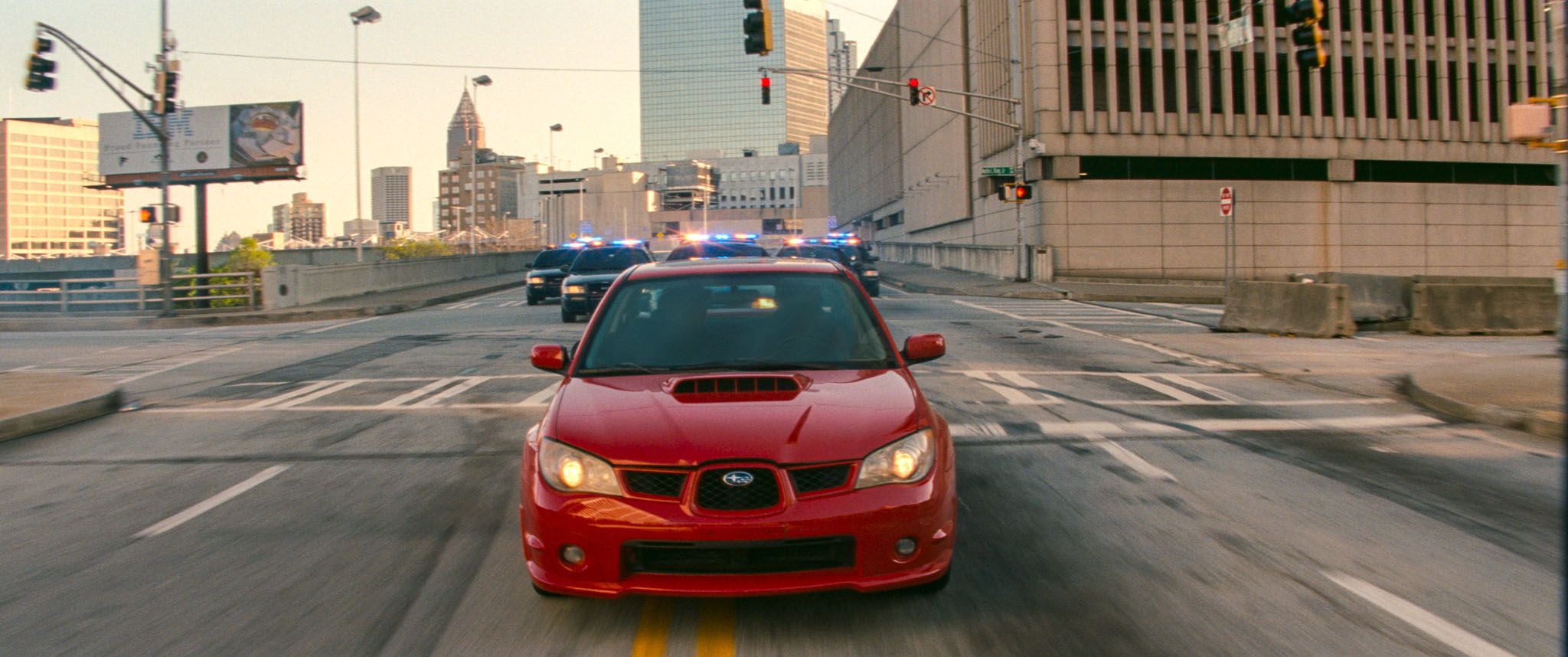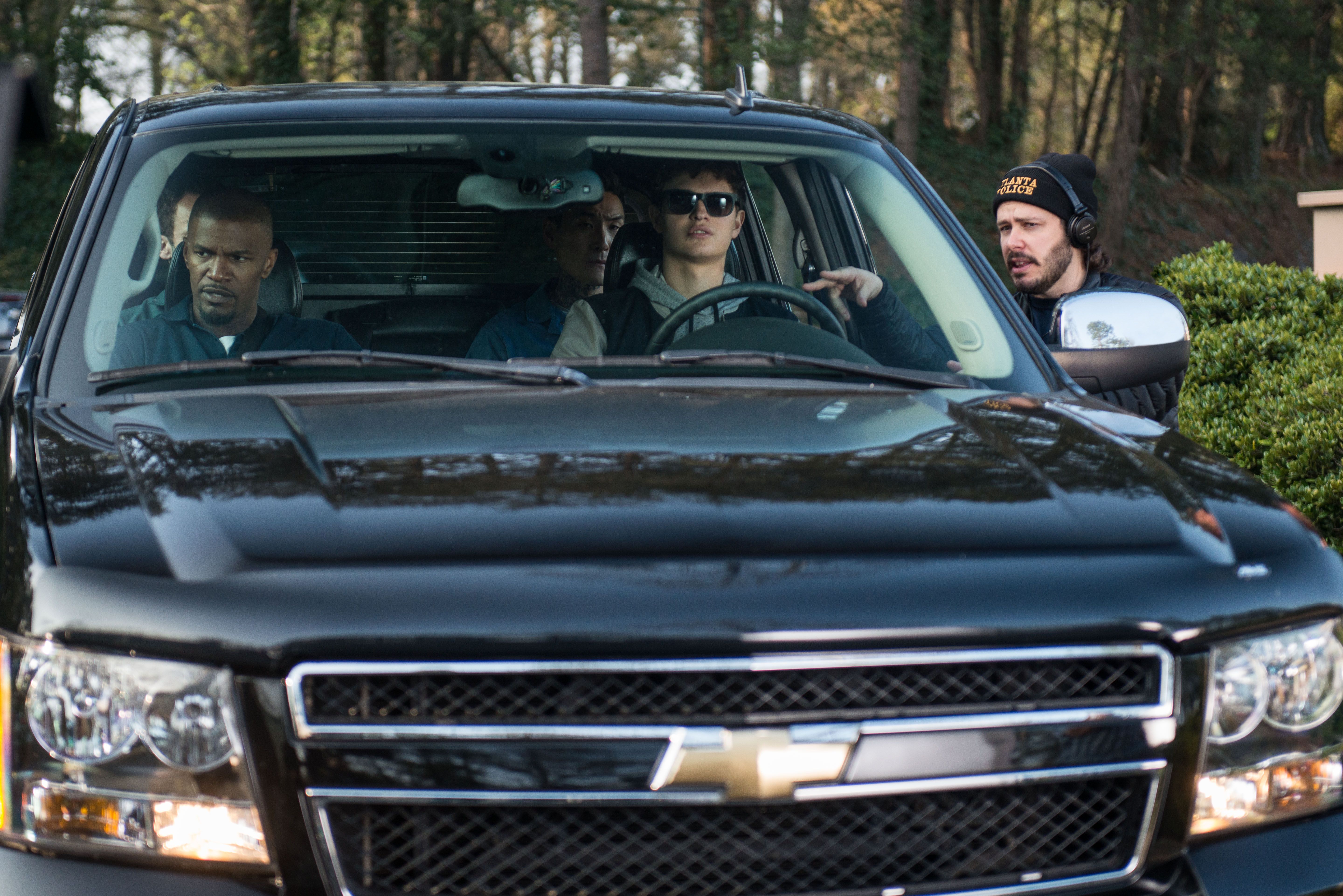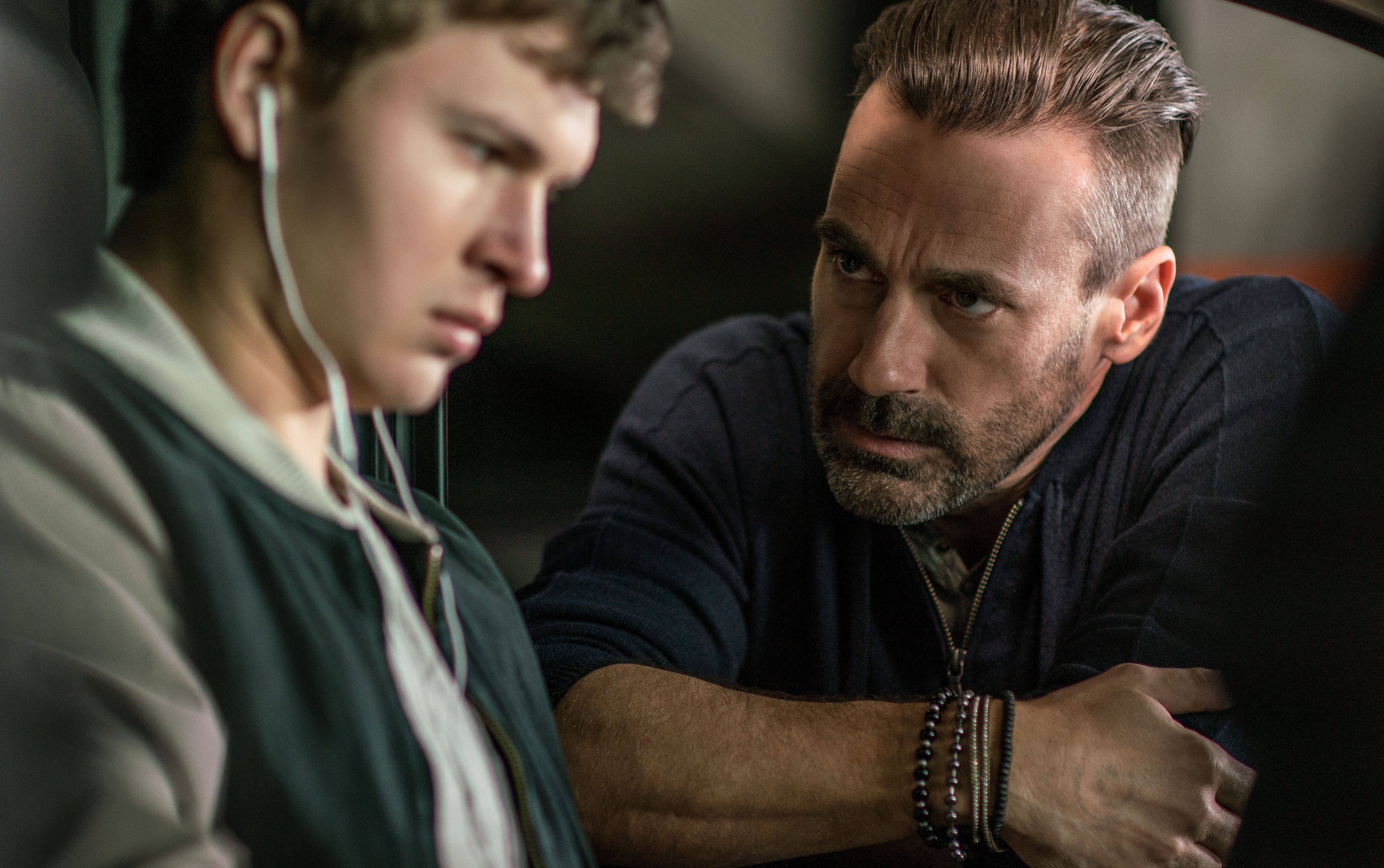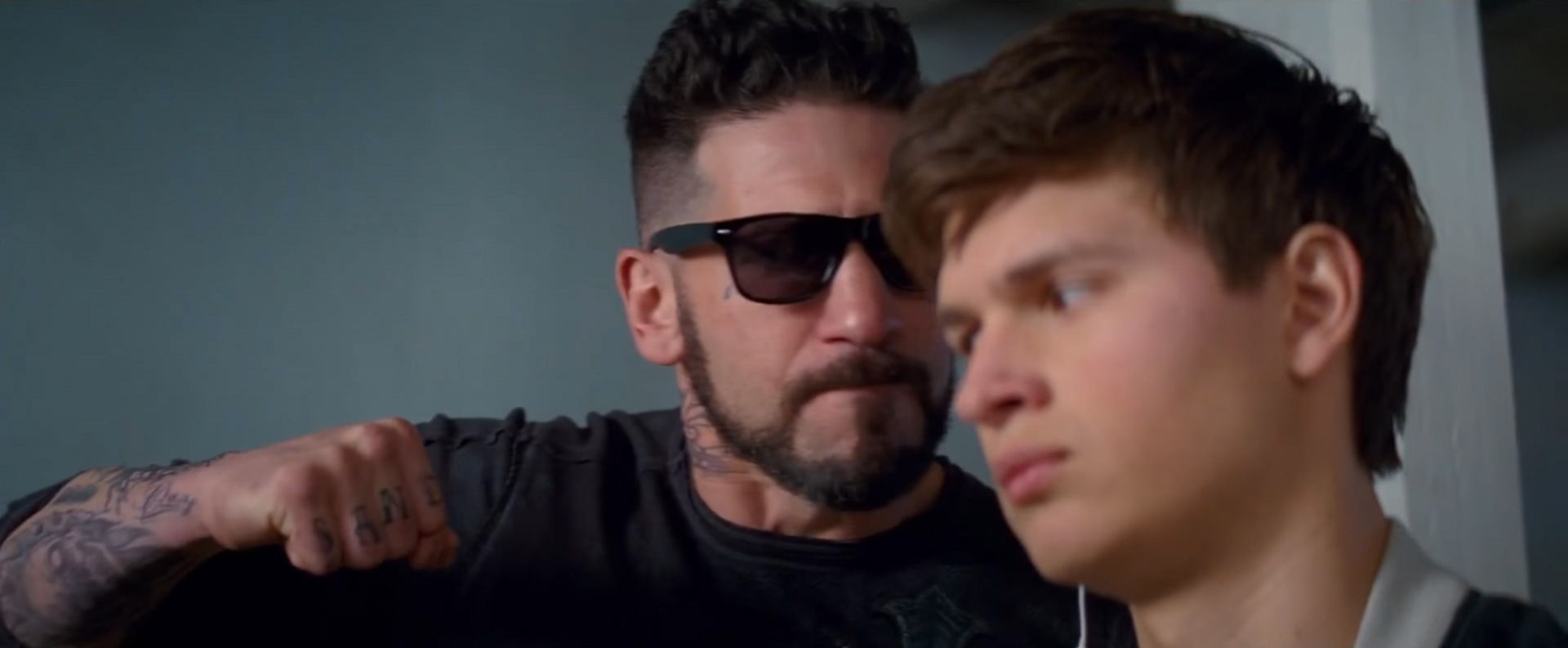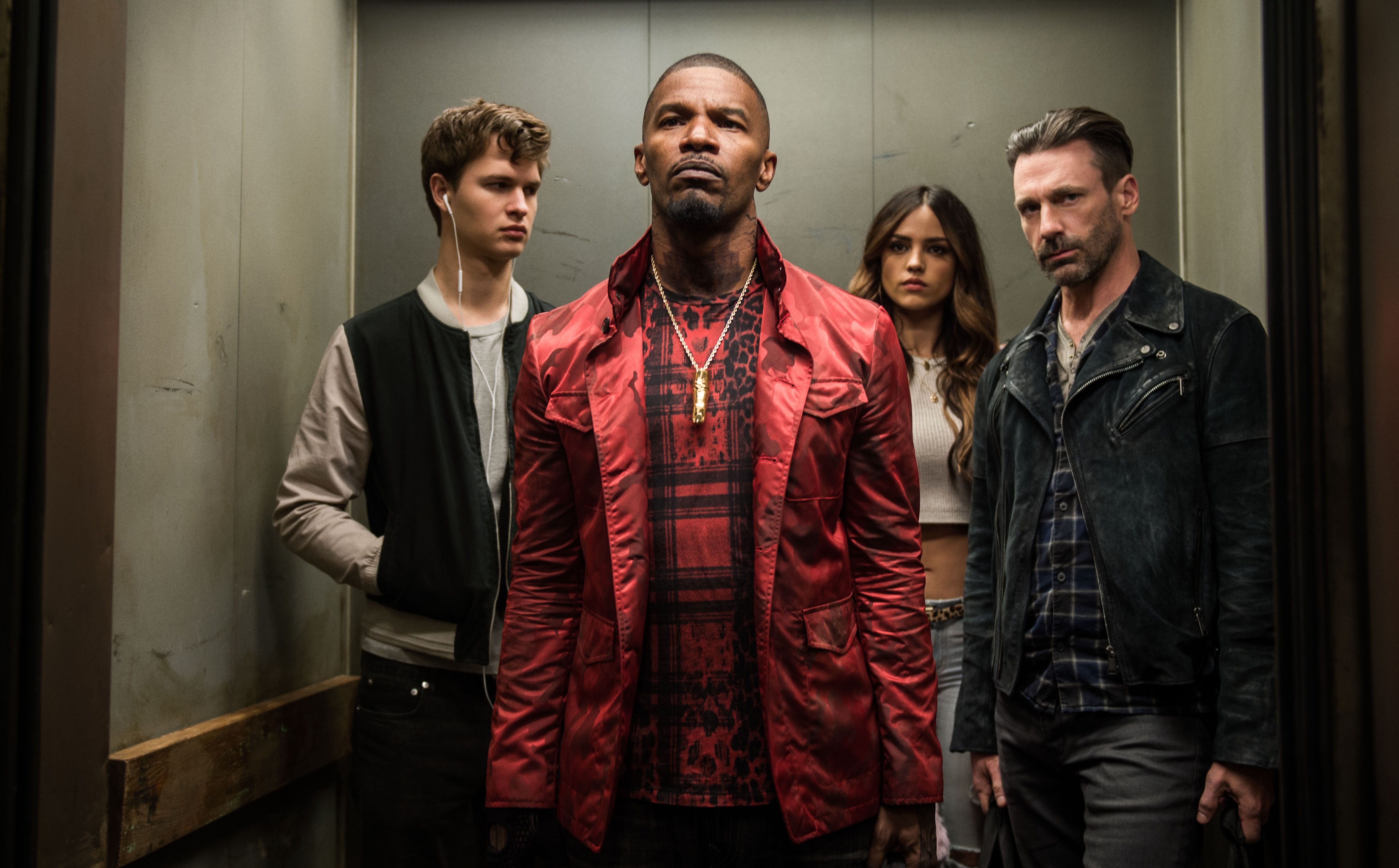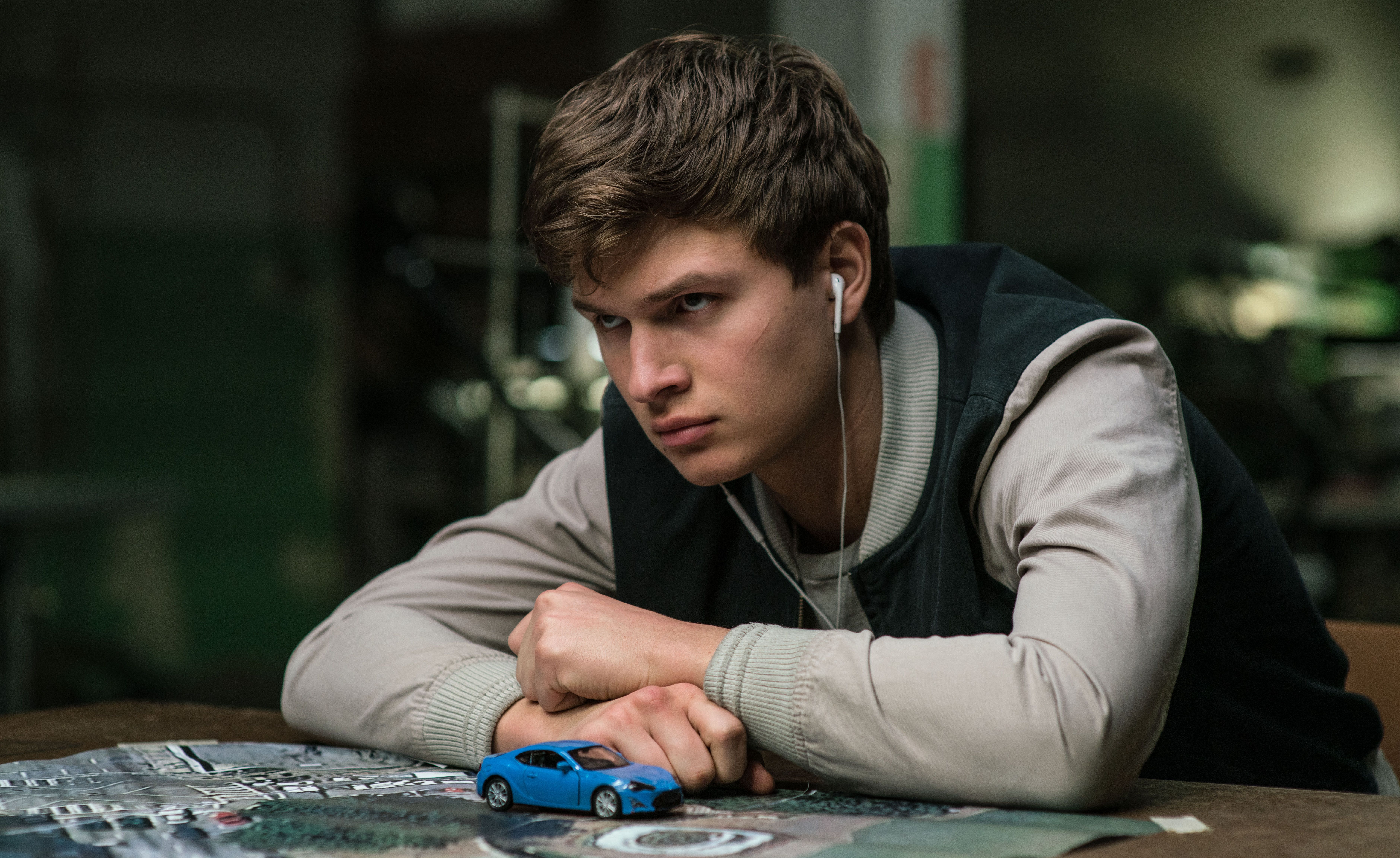I was bummed when Edgar Wright left Ant-Man because I wanted to see him make a movie in my native Atlanta. It turns out that time (and generous tax incentives) heal all wounds, because Wright not only came to Atlanta for his next movie, Baby Driver—he chose to set it in the city as well. So I was thrilled last year when I got to visit the set of the film along with a group of other journalists in April 2016 to see Wright at work.
For those who aren’t familiar with the movie, it follows Baby (Ansel Elgort), a skilled getaway driver who’s also losing his hearing. He’s always listening to music to drown out the humming in his ears, and when he decides to get away from his life of crime, he must contend with the crew of angry criminals he once worked with. The film also stars Kevin Spacey, Lily James, Jon Bernthal, Eiza González, Jon Hamm, Jamie Foxx, and Flea.
During our visit, we learned some cool things about the movie, which I’ve helpfully divided up into sections below for your reading pleasure.
The Filming
The main scene we saw being filmed when we visited on April 6, 2016—day 34 of a 56-day shoot—was a car hijacking where Baby and his crew, which also includes the temperamental Bats (Jamie Foxx), are pulling a mother and her child out of the car. Since Wright doesn’t do ugly, mean-spirited films, he has some fun with this situation, showing how the criminals are stealing a woman’s car, but they’re also careful with the child. The group of criminals are wearing Austin Powers’ masks (you’ve seen the joke explained in the trailer), and as they try to steal the car, the woman cries out, “I have a child!” to which Bats responds, “I have one too! Get out!” It was fun to watch, and I’m sure it will be even better when it’s all cut together with Wright’s kinetic style of directing.
Writer-Director Edgar Wright
- Wright started writing the script in 2007, but has the idea long before that. It’s his first solo script since his first movie, A Fistful of Fingers.
- To try and be more authentic to writing an American crime film, Wright spoke with ex-convict Joe Loya as a resource: “I met this guy who's amazing, an ex-convict who is now a writer called Joe Loya who wrote a book called The Man Who Outgrew His Prison Cell, and I found him through a researcher and we became friendly. So when I would write pages I would sometimes send them to him and say 'Does this sound kind of real?' I'm real aware of being English and middle class and writing an American crime film, so I may as well get the okay from someone who has been inside for ten years.”
- It’s not a musical like Mamma Mia! or something like that, but it’s very reliant on the music, and the music is always present in the scene: “The songs are always sourced, they're either in his ears or playing in a diner or playing on a stereo, so there's always within the scenes. So that's the premise of it really.”
- The film’s influences: “Obviously Scorsese or Tarantino's films, but a big influence on me are Walter Hill's movies. Walter Hill's early movies like The Driver and The Warriors, I love those movies and I liked his style. Walter is somebody else that I've gotten to know through doing Q&As so I've made him fully aware, I've said 'You know I'm totally ripping you off, right? We'll call it a big tribute to you.'”
- Since Atlanta has a big music scene, we had to ask if any Atlanta music made it into the film (since this interview, we learned that he added the original track “Chase Me”, features Danger Mouse, Big Boi, and Run the Jewels, who all have Atlanta ties): “There was a track, the one track that I couldn't clear was an Atlanta track. I tried to find something else but I want to find something that's like an Atlanta sound. The track I wanted to use they hadn't cleared one of their samples. We'll see, there will be something.”
- Why he cast Ansel Elgort in the lead role: “I like that he's very musical. He plays instruments, he can dance. He's a DJ as well, he writes music, so that aspect of it...He's also very young so he qualifies as a baby. There's also the idea that someone like him, Ansel just turned 22, but to have him in the same frame with Jon Hamm, Jamie Foxx Kevin Spacey, and Jon Bernthal, it's great. You want to feel like the character is very young, it's the point of the movie.”
- Although the movie shares its title with a Simon & Garfunkel song, that song doesn’t tie into the movie. Wright just really likes that song.
- The reason why he decided to set the film in Atlanta: “So as soon as we knew that it was a possibility and I came to kind of look at it, I decided to rewrite it for Atlanta and I immediately became invested in doing it here. There are also elements of the story that make a lot of sense here in terms of the music scene and the love of cars. I've never seen a city with more muscle cars in my life...and the crime. So it actually worked pretty well. I think the thing is whenever I've been here before, and I've only ever been here on press tours because Shaun of the Dead was the first time I came to Atlanta, so I think the last couple of times I went I made a real point of not going to the touristy spots but trying to see the rest of the city and the places that you don't usually go.”
- Wright did a read-through of the script in 2012, and Jon Hamm is the only actor who did the read-through who’s playing the same character in the film.
Producer Nira Park
- The music has been the same since they first started putting together the film: “It has stuck the same, and actually the music has hardly changed. There’s been a bit, but the starting point was the tracks so everyone had the tracklisting, we started clearing the music ages ago. All the music was cleared a long, long time before we started pre-production. Which was the thing, the studio were like, ‘How are you going to clear the music?’ And we were like, ‘We’ve cleared the music.’”
- The movie was first set in L.A., then New Orleans, and finally in Atlanta.
- On making their first movie in America: “It is very different filming in America. Obviously this is the first one that Edgar has done in America, we’ve actually worked a bit in America before, but shot in America is the first time for Edgar. But it is different, because we don’t have the same restrictions, the same unions, we obviously work on a much lower budget in the UK. It is different, we are working within different parameters, we just are. But obviously we have brought quite a few of our HODs with us, we’ve got the same core group that we have had since the beginning, so it’s just a learning process for some.”
Costume Designer Courtney Hoffman
- On designing Baby’s costume: We wanted to make sure it wasn’t something that felt trending or contemporary or like ‘hot.’ It had to be something that served what his character loves and ideals, and he’s sort of lives in this ‘50s fantasy in a way, so we wanted something that felt like he could be, he’s once in the script described as the Gene Kelly of the coffee run and so we wanted something that had a classic look to it that was, also at the same time, he’s experiencing this world in a sort of a black-and-white way, so we liked the idea of him being in black and white while he’s surrounded by all these characters.
- Every character has been assigned a color. “So Bats…is red; and Darling, who is Eiza Gonzalez, is pink and purple; and Jon Hamm is blue.”
- “One of the things that was also really inspiring about being in Atlanta is you have this cityscape that’s grey and monochromatic and then you see these bright flashes of color whether it’s a guy walking down the street in all red head to toe or graffiti, and so we wanted the palette of the movie to have that same quality to it.”
- One of the cool, subtle things you should look for with Baby’s costume throughout the film: “I gradually dyed a white shirt to be four stages of white to grey and so he starts gradually becoming metal because the whole point is he’s not invested in being in the crime world and now he’s getting sucked into it and the deeper he’s getting into it he starts becoming darker and then he, you know, gets blood on it and dirt on it and it gets ripped and stuff starts happening to it. So he pretty much starts on a canvas, a white canvas, and then we sort of built from there.”
- On designing costumes for an Edgar Wright film: “I think that the biggest thing for me about Edgar’s films are there’s almost a two-dimensional aspect to the aesthetic where it feels like a comic book or it feels like a video game, so I think it’s important to keep that and Quentin [Tarantino] is the same way. He designs his characters, the way he thinks of them is the same way where it’s almost like they’re thinking about what people will imagine the characters to look like after the movie or if you drew them out, if you, like, fan art.”
- She jokes that they went through what felt like 800 jackets to find the right one for Baby. “The thing is we really wanted something, you know, it’s finding that balance between something that’s obviously Ansel Elgort is someone who has teen fans and he’s part of these franchises so you want him to be cute and handsome but at the same time Baby probably doesn't buy new clothes and his stuff hasn’t been altered to fit him, so finding places where something could be a little ill-fitting.”
- Hoffman’s reasoning on giving Debra (Lily James), a unique set of boots: “So like even when he asks her out on a date and they go to this fancy restaurant, she always has this pair of boots on. That is her character, so even when she’s wearing a uniform, which isn’t something she chose to wear, you can tell that underneath it she is making her own decisions, she is a thoughtful woman and she’s not just going along for the ride.”
- On how working with Edgar Wright compares to working with Quentin Tarantino: “Quentin kind of comes from a place of like, ‘You’re gonna fuck it up until I see you didn’t fuck it up,’ because he knows exactly what it is in his head, but he doesn’t know how to tell you until he sees it, whereas Edgar is much more evolutionary within that with a lot of opinions still and with a lot of feedback.”
- The costumes also evolve over the course of the films with regards to what they wear for the heists: “One of the things that they open the movie in are these skeleton masks that I found because one of my favorite grips on Hateful Eight always wore them in the snow and they’re terrifying! They’re like half face masks that make your face look like [it] has a skeleton or clown or other horrifying things. I don’t know why anyone buys them, but I immediately thought of them for this as something that was different from… I didn’t want to go generic. I didn’t want ski masks, I didn’t want to make it the obvious choices so we got around it in other ways. So they all are really different. I don’t know… I did struggle a little bit with like, ‘Who’s making the calls of why they’re wearing what?’ But that was something that I was like, ‘Well, I will.’ So in the end, the last sequence I said like… the first sequence they start off in all black and by the end I said, ‘You know, they’ve gone through this whole movie, let’s let them be their characters’ colors. Let’s let them be those characters.’”
- On the characters’ tattoos: “Like Flea, and you see all these… and it’s transformative and Jamie especially, I couldn’t even, I like weirdly didn’t even, when he put his tattoos on it was really transformative to the character and it really fit with the clothes and it really hardened him and it was really cool the way that the tattoo design, it really is almost like another layer of their costumes and there were times where I was designing around the tattoos, like we wanted to make sure we see the chest tattoos so we gotta make sure the tank top is scooped or, you know, whatever. But there are a lot of tattoos on this movie.”
The Cars & Stunts
- “Yes we have roughly about 150 cars. Everything that's stunt material to background cars. Almost every car in this movie is designed specifically for something so although we have 5 Avalanches, each Avalanche is built slightly different from one from the other, depending on the stunt they do,” says Sean Ryan, who’s involved with outfitting the cars for their various tasks.
- If you’re wondering what goes into outfitting a regular car so it can handle some of the stunts the movie requires, Ryan had a pretty in-depth explanation: “The Subarus, we started out with 3, then we went to 4 and then we went to 5. And one in particular I could show you a shot. It’s an awesome shot. They come down this alley and this Subaru we set up, it has locking front and rear differential and Jeremy Fry the stunt guy, he tells us what he needs and we build them according to him to do the stunt. So as he is coming down this alley there is three trucks, one truck backing up, he weaves into a very thread the needle space and then comes back out of it and in order to do that shot we had to set up a locking differentials with the opportunity, once he got through that shot he hit a switch and it would unlock all the power to the rear wheels for him to pull out of that shot.
- We went and tested our first Subaru and they were pretty rough on him. We had to re-build the engine after that one. After last week in second unit work we had to put two new clutches in two of them so they are a little hard on him but they have gotten some amazing shots.”
- On what happens if you pit a Mercedes against a Prius: “Okay so we were doing a test in the Red Deck ... we were shooting in the Red Deck and we got some incredible footage with the Mercedes and one of it was the Charger chasing the Mercedes backwards and you are going probably 50 miles an hour. We did all night one night and we came back to finish it the second night and Jay the guy that did this shot lost control over it and hit a Prius that we did not own and it destroyed the Prius. I mean destroyed it. It broke a taillight, the Mercedes.”
- On films with blockbuster budgets, they can afford multiples of the cars they need, but with Baby Driver, each car had to be designed to an exact purpose: “We have multiple cars and each car is specifically designed for a stunt. With some of the bigger budgets we would have multiples of those cars designed. So we are really working with each car, we essentially only have one car to do each stunt so Jeremy is extremely good and he has been excellent at getting in and out, getting the shots without damaging the cars.”
- Newer cars also offer unforeseen problems, like how they’re resistant to changes that the production might need in order to pull off a certain stunt. For example, Ryan recalls challenges they had with a Mercedes: “For instance, the Mercedes obviously...it is a 2014-15. Its the brand new body style and Mercedes, they are super smart. They come with a lot of problems, they do not like to do what we are trying to do with them. We tried to trick the computer by mapping it and we did that three times. We plugged it back in and it went right back to the original settings. Mercedes gave us the cars for free with the intent to destroy. (Laughs) $140,000 cars. Yeah, no big deal. So I called Mercedes up and I say "Hey, you know, this is what we're trying to do and we need your codes" and they laughed and they said "Absolutely not."
Special Effects Supervisor Mark Byers
- On the different kinds of rigs and how everything is set to music: “We’ve had lots of discussions with Edgar for months now and he has a really lot of cool visions that he wants to get across that we’ve executed. It’s been great. The music is a new theme. It’s pretty cool how we have several different rigs: windshield wiper rigs, raindrop rig, obviously, gunfire [rigs], some of the body hits and car hits and explosions all go to music. Which is kind of cool.”
- On trying to fit the effects around the music: “The songs have been out there for years, he’s just fit them into scenes of the movie. And when there’s certain percussions and different things that would escalate and happen we have to make those effects happen on those cues.”
- Films like Mad Max: Fury Road and Baby Driver have helped reinvigorate the use of practical effects when it comes to cars: “It’s a little bit of a throwback to how we always used to do it, right before all the CGI came in. That’s kind of taken over a lot of these movies, where all we end up doing is some explosions and throwing some cars around and everything that actually makes that happen is all some sort of CG monster thing we don’t really interact with – which is a different way to make a movie. But a lot of that’s happened. Movies like Fury Road and some others that really got back to the basics of practical, physical effects with the actors is great. I love it.”
- The chases will be more about maneuvering rather than smash-em-up getaways: “They are heavy maneuver getaways. Very close calls. Very orchestrated. Lots of close calls and some cool rigs that you think they’re doomed but they get out of it. Pretty cool.”
- On trying to get the right shot without delaying traffic for too long: “…we do a lot on open streets and freeways that the public is around so we have very short moments to execute and then let the traffic go again, and then regroup and be able to have someone on traffic breaks where we don’t get a lot of time.”
- The gunfights provided their own challenge because, like everything else, they’re cued up to be with the beat of the music.
- Byers explains how even differences of even a second or two can throw everything off because of how the music dictates the beat: “All those things, yeah. It’s hard enough just thinking about it but we shoot a scene where there’s dialogue, they get out of the car and continue, there’s dialogue – and that’s all to music – and then it escalates to gunfire which is all to music. They get out of the car different every time. They take a different step every time. They elongate the second, two second, three second differences and things do it doesn’t line up with the music so they have to go again. Everybody has to do it the exact same so the beat happens at the right time, so the gunfire does, because you can’t change the song.”
Ansel Elgort (Baby) & Jon Hamm (Buddy)
- The relationship between Baby and Buddy changes over the course of the film, but it starts out as a kind of older brother/younger brother relationship.
- Hamm laughs off doing his own stunts. “I’m 45 years old and I break easily… I used to be a lot more comfortable with doing a lot of that stuff and now I’m a lot less comfortable the day after doing a lot of that stuff.”
- There’s a time-editing happening on set every day so the actors can see what they have and what they don’t have.
- The reason Baby is working for Doc (Kevin Spacey) is that Baby stole a car from Doc that was filled with contraband, and so he’s sort of roped into working with Doc as a way to repay the theft.
- Baby doesn’t like violence, but he loves driving.
- “Edgar’s crazy encyclopedic knowledge of film is only matched by his crazy encyclopedic knowledge of music, and he has this really cool offbeat interesting playlist and sense of music that fits with all this stuff. It’s incredibly eclectic, it’s bands that you might’ve heard of or musicians you might’ve heard of, but it’s deep cuts of their stuff,” says Hamm.
- Elgort on Wright’s insane work schedule: “He’ll go from first unit, working all day, and then we’ll finish at like 4 AM and then he is on second unit the next day at 7 AM. And he’s like, ‘I didn’t sleep, I can’t not be on set all the time.’”
- While making the movie, Elgort, Foxx, and Flea would spend time working on a record together: “And then Flea from the Chilli Peppers is in this movie, and like me and Jamie and Flea went to the music studio after work, we’re gonna go again Monday and Tuesday, we’re like working on a record together,” says Elgort.
Jon Bernthal (Griff)
- On Griff’s relationship with Baby: “I think he's a little bit of a heavy. I think he's got some real doubts about this fresh-faced youngster who's got so much responsibility on his hands, and I think that'll play out as we play more of it.”
- On working with Edgar Wright versus other directors: “Every director, every job is different. I think with this particular project, it's so specific, this movie already existed in Edgar's mind before. You know, sometimes you get called into something and even with the great directors, it's kind of like, you all get there and you play and you sort of figure it out, what it is. I think he's different. I think these films exist in his mind before you get there.”
- How he feels about his character: “I think in this situation, I think the idea behind him is, he's kind of the guy who's good to have in a pinch, but like, man he can be annoying, you know what I mean? I think he's loud and brash and he does not keep his opinions to himself.”
- His thoughts on doing stunts: “I was an athlete and I was a boxer and I'll do certain things but I'm full of fears, just like anyone else. I've got kids, I want to go home. But there's something, for me, when someone points a camera at me, I just so believe in the crew and everyone. There's literally nothing I wouldn't do if you told me to jump off this building, "You gonna be all right," there's so much trust in the film crew, and I believe in that wholeheartedly. And that camera, it gives you big giant balls, you know what I'm saying? Excuse my expression here.
- Why he prefers practical effects to digital effects: “I mean, look, not to take away from digital effects artists, because they're artists in their own right, but to me, there's practical, it's practical, practical, practical, it's right there, you can touch it, you can see it, you can react off of it. You know, I always not only prefer that, but I think actors, your greatest tool is your imagination. So there's a lot of stuff you can do with green screen and all that, but you know, when there's real blood to feel and play with and play off of and you're really seeing what's going on and you can touch it and feel it, I think it just provides so much more opportunity to explore, to create.”
Jamie Foxx (Bats), Eiza González (Darling), & Flea (Eddie)
- González says that her character, Darling, has a “Bonnie and Clyde” thing going on with Buddy (Hamm).
- “She has such a cool energy and she's such a badass, but she's kind of like a space cadet as well. She's like all smiles but she's just kookoo,” González says of her character.
- For González, Baby Driver let her do gunplay, which she hadn’t had a chance to do before in her career.
- On working with Jon Hamm, Gonzalez says: “He's like, ‘Whatever you feel comfortable with, there's nothing that can bother me. This is a team and we're working together.’”
- In terms of the dynamic among the bank robbers, Bats and Jon are a little more crazy, whereas Darling and Buddy are “Okay, we’ve done a thousand bank heists. This is how it works.”
- It takes 25 minutes to apply all of Bats’ tattoos for Foxx.
- Foxx on trying to do the gunplay to the choreography: “Like, the bullets got to certain beats, so you go one, two, and then three, four, and then five, six. So, everything is timed. So you already know that you're like five, eight. But, at the same time, you're just pulling out the whole scene. So, it looks amazing.”
- Foxx describes Bats as an “angry dude. He’s killing everybody.”
- Flea describes his character, Eddie, as “A dastardly nihilistic bank robber with no moral compass, who is very displeased with the state of the world, so wants to rob banks, and whoever gets in his way needs to be eliminated.”
- Flea’s character has a tattoo reading 51-50, which is the police code for “insane.”
Closing Thoughts
It’s been far too long since we’ve seen an Edgar Wright film, but Baby Driver looks like it’s going to a blast. Everyone was incredibly excited about what they were working on, and they loved the way that they were approaching the story. From the cast to the crew, everyone was on the same page with Wright’s vision, and judging by the enthusiastic reviews out of SXSW earlier this year, it looks like the filmmaker has another terrific film on his hands.
Baby Driver opens June 28th.
For more from our Baby Driver set visit, click on the links below:

